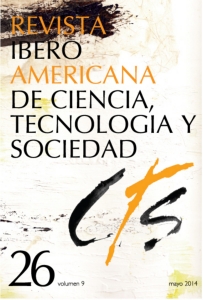Telecentros
A project for digital inclusion of poor youths?
DOI:
https://doi.org/10.52712/issn.1850-0013-606Keywords:
digital inclusion, internet, telecentrosAbstract
The aim of this paper is to present and discuss the main points of a research that investigates the relationship between Information and Communication Technologies and low-income Internet users. We asked ourselves if the use of the Internet by youngsters in establishments called “telecentros” in the city of Niterói could promote a successful digital inclusion initiative. Our theoretical support was composed by authors like Canclini, Cazeloto, Soares, Sorj and Warschauer, who observed the links between digital inclusion and social exclusion. The study was taken in five “telecentros”, by means of interviews and questionnaires. For data analysis we were supported by the Perelman and Olbrecths-Tyteca’s Theory of Argumentative Analysis. We concluded that the use of the Internet in “telecentros” does not promote digital inclusion as intended in the governmental discourse. Although such establishments create new spaces for social relationships between youngsters, the actions carried out there do not reduce the marginalization already established in this particular group.
Downloads
References
AMARAL, M. e BOHADANA, E. (2008): “Conectividade e mobilidade social: pilares da inclusão digital?”, Revista Contemporânea, vol. 6, nº 2, pp. 1-21.
CANCLINI, N. (2007): Diferentes, desiguais e desconectados: mapas da interculturalidade. Rio de Janeiro. Editora UFRJ.
CASTRO, M. (1997): Retóricas da rua: educador, criança e diálogos. Rio de Janeiro. Editora Universitária Amais.
CAZELOTO, E. (2008): Inclusão digital: uma visão crítica. São Paulo. Editora Senac.
CGI (2009): Pesquisa sobre o Uso das Tecnologias de Informação e da Comunicação no Brasil: TIC Domicílios e TIC Empresas 2008. Coordenação executiva e editorial Alexandre F. Barbosa, Comitê Gestor da Internet no Brasil.
CGI (2010): Análise dos Resultados da TIC Domicílios 2009. Série História – Total Brasil e área urbana, Comitê Gestor da Internet no Brasil.
FREIRE, P. (1994): Cartas à Cristina. São Paulo. Editora Paz e Terra.
FREIRE, P. (1997): Educação e mudança. Rio de Janeiro. Editora Paz e Terra.
FREIRE, P. e HORTON, M. (2003): O caminho se faz caminhando: conversas sobre educação e mudança social. Rio de Janeiro. Editora Vozes.
GOVERNO FEDERAL – INCLUSÃO DIGITAL (s/f): Programas governamentais para inclusão digital. Disponível em: http://www.inclusaodigital.gov.br/inclusao/outros- programas. Acesso em 10 de outubro de 2010.
IBGE (s/f): Cidades@. População jovem no município de Niterói, Estado do Rio de Janeiro. Disponível em: http://www.ibge.gov.br/cidadesat/topwindow.htm?1. Acesso em 20 de julho de 2009.
IBGE (s/f): Síntese de indicadores sociais, 2008ª, disponível em <http://www.ibge.gov.br/home/presidencia/noticias/noticia_visualiza.php?id_noticia=1 233&id_pagina=1> acesso em 20 de julho de 2009.
IBGE (s/f): Uma análise das condições de vida da população brasileira 2008b. Disponível em: http://www.ibge.gov.br/home/estatistica/populacao/condicaodevida /indicadoresminimos/sinteseindicsociais2008/indic_sociais2008.pdf. Acesso em 20 de maio de 2009.
MATTOS, F. e CHAGAS, G. J. (2008): “Desafios para inclusão digital no Brasil”, Revista Perspectiva en Ciência da Informação, vol. 13, nº1, pp 67-94.
MINISTÉRIO DAS COMUNICAÇÕES (s/f): O que é um Telecentro e para que serve ?, disponível em <http://www.idbrasil.gov.br/docs_telecentro/docs_telecentro/o_que _e> acesso em 22 de outubro de 2008.
MINISTÉRIO DA FAZENDA (s/f): Inclusão digital. Disponível em: http://www.serpro.gov.br/inclusao/oprograma. Acesso em 11 de junho de 2010.
OBSERVATÓRIO NACIONAL DE INCLUSÃO DIGITAL (s/f): Mapa dos telecentros no Brasil. Disponível em: http://www.onid.org.br. Acesso em 20 de junho de 2009.
PERELMAN, C. e OLBRECTHS-TYTECA, L. (2005): Tratado da Argumentação: a nova retórica, 2ªed, São Paulo, Editora Martins Fontes.
RIZZINI, I. et al (1999): Pesquisando... guia de metodologias de pesquisa para programas sociais, Rio de Janeiro, Editora Santa Úrsula.
SECRETARIA DE ENSINO À DISTÂNCIA (s/f): Programas para inclusão digital. Disponível em: <http://portal.mec.gov.br/index.php?option=con_content&view= article&id=12502&Itemid=823>. Acesso em 20 de julho de 2009.
SOARES, M. (2004): “Letramento e alfabetização: as muitas facetas”, Revista Brasileira de Educação, nº 25, pp. 5-17.
SORJ, B. e GUEDES L. E. (2005): “Exclusão digital”, Revista Novos Estudos, nº 72, pp. 101-117.
WARSCHAUER, M. (2006): Tecnologia e inclusão digital: a exclusão digital em debate, São Paulo, Editora SENAC.
Downloads
Published
How to Cite
Issue
Section
License
Copyright (c) 2024 CC Attribution 4.0

This work is licensed under a Creative Commons Attribution 4.0 International License.
All CTS's issues and academic articles are under a CC-BY license.
Since 2007, CTS has provided open and free access to all its contents, including the complete archive of its quarterly edition and the different products presented in its electronic platform. This decision is based on the belief that offering free access to published materials helps to build a greater and better exchange of knowledge.
In turn, for the quarterly edition, CTS allows institutional and thematic repositories, as well as personal web pages, to self-archive articles in their post-print or editorial version, immediately after the publication of the final version of each issue and under the condition that a link to the original source will be incorporated into the self-archive.











